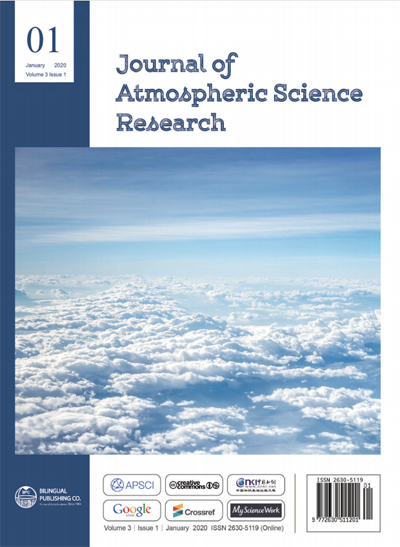-
2081
-
1502
-
1495
-
1366
-
1230
Thumb Rule for Nowcast of Dust Storm and Strong Squally Winds over Delhi NCR using DWR Data
DOI:
https://doi.org/10.30564/jasr.v3i1.1926Abstract
Squally winds are the natural hazards and are often associated with the severe thunderstorms (TS), which mostly affects plains of North West India during pre monsoon season (March to May). Squally winds of the order more than 60 kmph are very devastating. Under influence of these strong squally winds trees, electricity poles, advertisement sign boards fall, sometimes human life is also lost. The main objective of this study is to find out the thumb rule based on Doppler Weather Radar (DWR) Data to Nowcast the squally winds over a region. To detect thumb rule, five cases of thunder storm accompanied with squally winds ranging from (55 kmph to 110 kmph) are taken in to consideration. These TS’s occurred over Delhi NCR (National Capital Region) during May - June 2018. Maximum reflectivity (Max Z) data of Delhi DWR, Cloud Top Temperature (CTT) data from INSAT and squally winds along with other weather parameters observed at Safdarjung and Palam observatories are utilized to find out the Thumb Rule. Based on the analysis, it is concluded that presence of a western disturbance (WD), presence of East-West trough from North-west Rajasthan upto East UP through south Haryana and very high temperature of the order of 40 degree Celsius over the nearby area are very conducive for occurrence of squally winds accompanied with thunderstorms. Thumb rule find out in this study is that, squally winds of the order of 55 kmph or more will effect a station if a thunderstorm (having Max Z echo with vertical extension of cell >7 km, reflectivity >45 dBz and at a distance of more than 100 km from the station) moving towards station is present in one to two hour before images of Doppler Weather Radar.
Keywords:
Doppler Weather Radar, Squally winds, Thunderstorm, Dust storm, Now-castReferences
[1] Arora PK, Srivastava TP. Utilisation of Aerostat Doppler Weather Radar in nowcasting of convective phenomena. Mausam, 2010, 61(1): 95-104.
[2] Fujita TT, Wakimoto RM. Five scales of airflow associated with a series of downbursts on 16 July 1980. Mon Wea Rev, 1981, 109: 1438-1456.
[3] Mercer A, Dyer J. A New Scheme for Daily Peak Wind Gust Prediction Using Machine Learning. Procedia Computer Science, 2014, 36: 593-598.
[4] Ray Kamaljit, Kannan B A M, Sharma P, Sen B, Warsi A H. Severe Thunderstorm Activities over India During SAARC STORM Project 2014-2015: Study Based on Radar. VayuMandal, 2017, 43(2): 30-46.
[5] Sahu R, Dadich J, Tyagi B, Vissa N K, Singh J. Evaluating the impact of climate change in threshold values of thermodynamic indices during pre-monsoon thunderstorm season over Eastern India. Natural Hazards, 2020, Published on line: 07 May 2020.
[6] Srivastava Kuldeep, Lau S, Yeung HY, Cheng TL, et al. Use of SWIRLS Nowcasting System for quantitative precipitation forecast using Indian DWR data, Mausam, 2012, 63(1): 1-16.
[7] Srivastava Kuldeep, Bhardwaj Rashmi. Real-time nowcast of a cloudburst and a thunderstorm event with assimilation of Doppler weather radar data. Natural Hazards, 2014, 70: 1357-1383.
[8] Suresh R., Bhatnagar A K. Unsual Hailstorms during May 2002 in Chennai & suburbs Study using data from a single Doppler Weather Radar. Mausam, 2004, 55(4): 655-670.
[9] Tyagi Ajit. Thunderstorm climatology over Indian region, Mausam. 2007, 58(2): 189-212.
[10] Tyagi Ajit, Sikka D R, Goyal Suman, et. al. A Satellite Based Study of Pre-Monsoon Thunderstorms (Nor’westers) over Eastern India and their organization into Mesoscale Convective Complexes. Mausam, 2012, 63(1): 29-54.




 Kuldeep Srivastava
Kuldeep Srivastava





